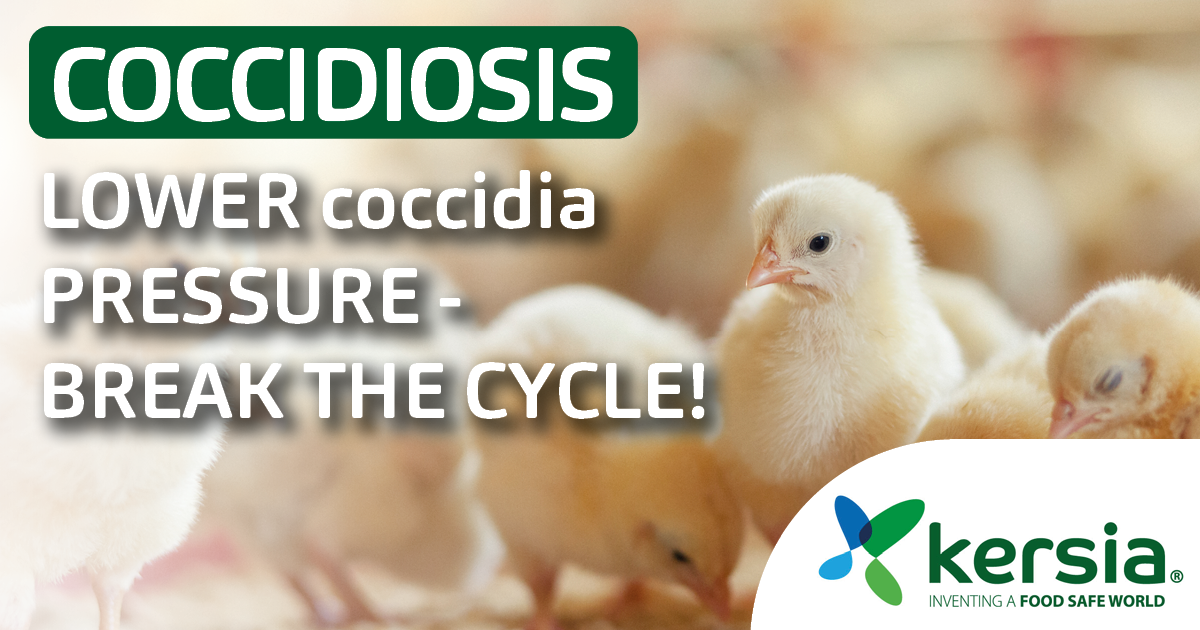What is coccidiosis?
Coccidiosis is a parasitic disease which causes destruction of in the intestinal tract. It is caused by a single-celled organism, a protozoa from genus Eimeria, called coccidia. Coccidia is sub-classified into a number of genera (groups), and each genus (group) has a number of species.
In chickens, there are seven species recognized but only six are the important ones:
- For broilers (up to +/- 6 weeks) 4 species are most important:
- acervulina
- maxima
- tenella
- mitis
- For older chickens two more species are important
- necatrix
- brunetti
How is poultry infected?
The oocysts in the surrounding are being taken up by poultry orally, are crushed in the gizzard which sets the sporozoites free. These enter epithelial cells intestines and destroy them, leading to unsporulated oocysts which are releases with faeces. The cycle starts than all over again and again…
Coccidiosis – Clinical and Subclinical
Coccidia damage can quickly cause very high costs due mortality, feed conversion rate or the use of anticoccidials. We need to make the difference between clinical coccidiosis, causing mortality and blood in faeces and subclinical coccidiosis, which damages the birds enteric epithelial cells with no major clinical signs. The subclinical coccidiosis reduces the nutrition absorption leading to less body weight gain of appr. 5-10% and a reduced performance in the feed conversion, i.e. an increase of the feed conversion rate by approximately 5-10%.
Note: The subclinical form is responsible for appr. 70-80% of the economic loss caused by coccidiosis!
The first symptoms of coccidia in chickens are fatigue, loss of appetite, weakness and emaciation. If there is bloody diarrhoea, there is a high probability of caecal coccidia infestation, while mucous diarrhoea might be a sign of small intestinal coccidiosis. In order to validate which type of coccidiosis it is, a faecal examination and lesion scoring are required.
What to do to lower the coccidia pressure and break the cycle?
When we have coccidia challenge, it is recommended to follow a specific hygiene program:
- CLEANING: After removing organic material through the dry cleaning step, apply a strong alkaline detergent such as ULTRAFOAM, ECOFOAM ADVANCED, ECOFOAM PLUS, AGACREAM etc. Use a high pressure rinsing to remove all dirt and let the shed dry completely.
- DISINFECTION:
- Disinfect the sheds – ground walls and ceiling – with a broad-spectrum disinfectant with proven efficacy like HYRED FORCE 7, VIROSHIELD, AGACID FORTE, VIREX or FUMAGRI EFFISAFE and let it dry afterwards.
- Apply a second round of disinfection on the ground floor & appr. 1m up the walls with a special and targeted disinfectant such as AGAKOK 2.5 or CYCLEX, both of which are Chlorocresol based disinfectants tested and approved against oocysts.
- PROTECTION: Follow stringent protection measures, such as foot dip, hand wash & disinfection, continuous water treatment etc. to avoid secondary infections through entrance of other pathogens to your shed.
Only by using AGAKOK 2.5 at 2%, or CYCLEX at 3%, application rate in the second step of a two round disinfection program, are you able to successfully LOWER COCCIDIA PRESSURE and BREAK THE CYCLE.
The program’s success is supported by meticulous attention to detail in the essential step of the cleaning of sheds and continuous protection by keeping clothing and equipment clean and disinfected.

